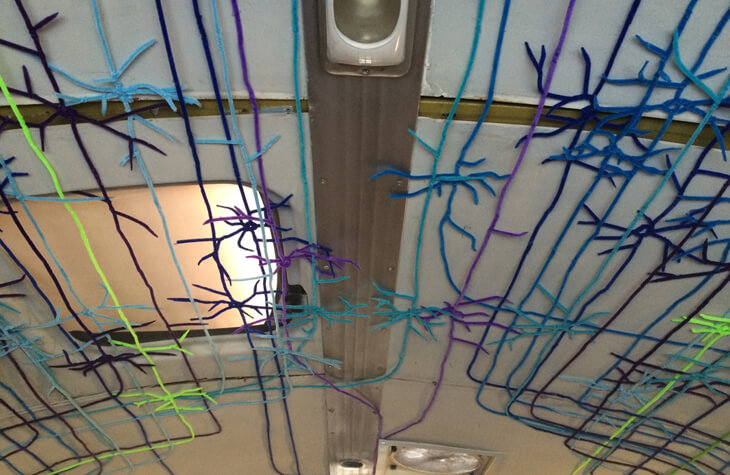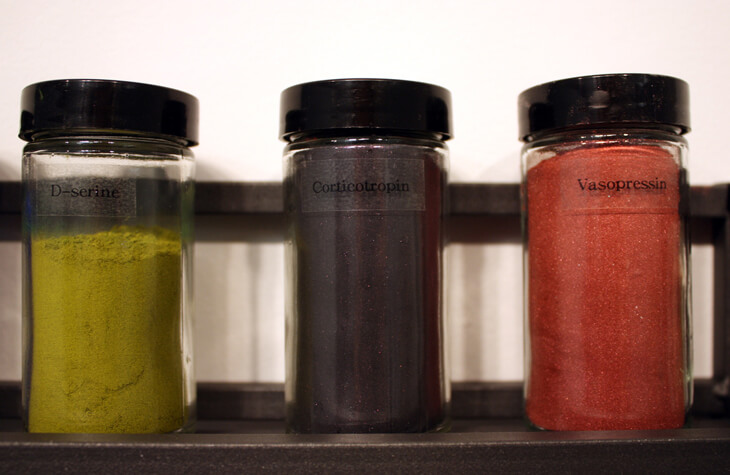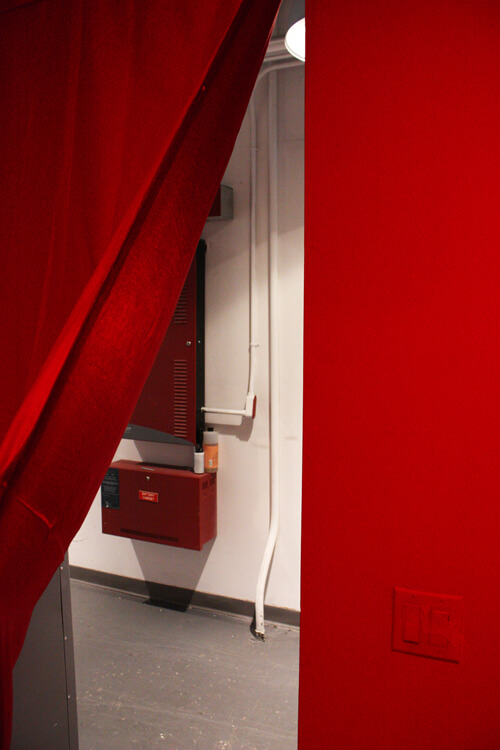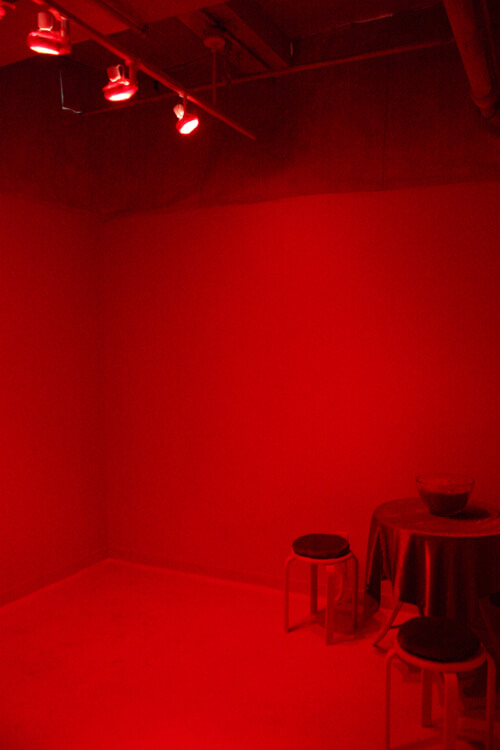Words by Lula Criado
The brain is the most complex organ in a vertebrate’s body. Neurons interconnected by synapses, nerve cells and – amino acids, peptides and monoamines to name just a few molecules and cells involved – work in perfect and fascinating harmony.
The creative universe of visual artist Julia Buntaine spans a range of mediums, from digital drawings and sculptures to installations, and is deeply connected to the brain and consciousness. With a background in Cognitive Neuroscience and Fine Arts, Buntaine crosses both art and science to bring the study of the brain to the viewer.
One of the projects that caught my attention most was Raw Feels, an immersive installation and multi-sensory experience that involves the senses of seeing, hearing and tasting. The conceptual frame of Raw Feels lies in the heart of the concept of the neural adaptation to the colour. This adaptation declines after prolonged stimulation because the cone cells – photoreceptors responsible for the perception of colour – are exhausted after staring at a particular colour for a minute or so.
On the other hand; January in the Frontal Lobe, one of Buntaine’s current projects, explores and opens a dialogue between learning, forgetting and changes in the brain at a cellular level. Through a series of digital drawings translated into an animated GIF, January in the Frontal Lobe takes inspiration from histology techniques to represent how the brain and its possible changes from day to day would look like.
For Julia Buntaine, founder and director of SciArt Center and founder and editor-in-chief of SciArt in America, art is a tool that helps decipher the enigma of the brain – matter, mind and consciousness.
What drew you into working in the intersection of neuroscience and the scientific study of the brain and art?
While art has been part of my life in a serious way since I was a teenager, I came to science during college, at Hampshire College, one day when I wandered into an Intro to Neuroscience course as a first year. I was looking for a subject matter in which to exercise my intellectual curiosity, and after that first class I felt like something clicked.
I found a certain comfort, and urgent fascination, in the science of the brain. In many ways, neuroscience is the most personal of the sciences, yet still fundamentally concrete and objective, which appeals to me greatly.
I was instantly hooked and ended up doing a double major in neuroscience and sculpture for the majority of college, running between the lab and the studio on a daily basis. At Hampshire College students design their own curriculums, so this wasn’t as unusual, or difficult, as it may have been elsewhere.
It was during my third year at Hampshire that I began to create neuroscience-based art. This came from a realization that while art was what I loved to do, neuroscience was what I loved to think about. Creating art about the brain helped me understand the science I was studying in a deeper, more bodily, and intuitive way; using the brain as my artistic subject matter gave me what I felt to be – and still do – a topic really worth making art about.
While I chose to pursue art professionally, I still do and always will create art about the brain. The wonder, the mystery – there is so much we have to learn, and thus my inspiration pool for ideas is essentially infinite. My studio is full of textbooks, old newspaper clippings, and research paper printouts, and I keep up with the latest in neuroscience through personal connections in the community.
Raw Feels is a phenomenological red installation which explores the feeling and consequences of eye exposure to the red colour. Did you document what a person with synesthesia feels?
To give a bit of context to this question, Raw Feels was a multi-sensory installation (my thesis piece in graduate school) that spoke to the qualia of the colour red. Qualia is a term used in the philosophy of mind and consciousness research to describe the specific internal and qualitative feelings of a conscious experience.
While my heartbeat, an autonomic and non-conscious function, would not be described as having a quale (singular of qualia), the experience of seeing the colour red sparks an intense internal experience that goes beyond the literal visual processing of the colour.
Think for a moment about the colour red… now think for a moment about the colour blue. Even thinking about these colours feels different. I chose red because across cultures red sparks the most disparate, and intense, associations including blood, lust, rage, death, and life.
Raw Feels hits you over the head with the feeling of the colour red – from the red walls and lights to the ‘red noise’ playing in the background to the Red Hots and red wine…. just as everyone has their own subjective experience of art, everyone has their own qualia-feelings, and thus the experience of the installation was extremely personalized.
I myself felt very comfortable in the room (most likely a byproduct of my having spent a full semester surrounded by it), while others became very excited (like my two-year-old nephew) or overwhelmed and anxious (like many of my teachers).
While I did not get the chance to invite any synesthetes I know to the installation, I’m sure their perceptions of the installation would have been very interesting.
Since everyone’s qualia experiences differ according to their own dispositions (your personality and life experience), physiology (the ~8% of men who are red/green colourblind, for example), brain chemistry (what mood you are in at a particular moment), memories (what associations you have with the colour red), a synesthete’s would have been one among an infinite number of possible experiences.
January In The Frontal Lobe is an interesting project which examines the process of learning and memory. This made me think about the process of un-learning that happens in dementia and Alzheimer. Could you tell us a little bit about the intellectual process?
That’s an interesting idea – about unlearning. Learning, forgetting, changing, and staying the same are all at play in this piece.
One thing I like to do in my work, like many artists, is make the invisible visible. In this case, how the brain changes on the cellular level, as seen in this “cross-section” style, is invisible simply because to see a cross-section, the brain must be dead and sliced.
Colour standing in for content, this piece is a meditation on how the brain changes day to day, based on my knowledge of the processes of learning and memory, and based on my introspective investigation of how thoughts and daily mental states can evolve over the course of a month.
The first ‘day’ is based directly on data from the Seung Lab, while the following 30 days are an educated, artistic approximation.
What directions do you imagine taking your work in?
There are a number of concepts that pop up over and over again in my work, such as the analogy between the brain and the city, the mechanisms of consciousness, how the perceptual system works, the beauty of neurobiological forms, and the way that science represents the brain via data.
I have a few ideas on the back burner, one involving the model organism c. elegans, the other inspired by a 60’ wax tree I recently saw at New York’s Hauser & Wirth gallery.
What is your chief enemy of creativity?
My chief enemy is definitely time. I’m the kind of person who would do really well with 30 hours days, instead of the short 24 we have. With my SciArt initiatives (SciArt in America, and SciArt Center of New York) and my art practice, there’s a constant battle between what ‘kind’ of, and how much work I have time in the day to do. Importantly, this is not a complaint.
Rather, wearing multiple professional hats makes the time that I spend on my artwork valuable and extremely productive. I simply don’t have time to procrastinate or lack inspiration.
You couldn’t live without…
What a strangely difficult question. Obviously, I couldn’t live without a lot of practical things or the subjects of this interview… I also couldn’t live without a good novel, cooking, house plants, New York City… or at least, I couldn’t live as well.










